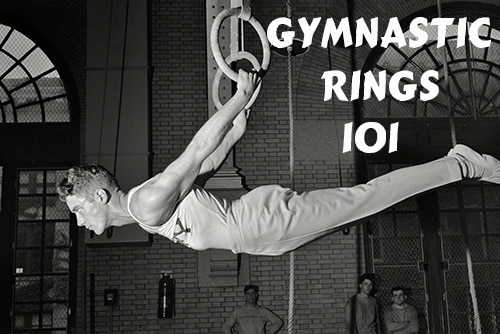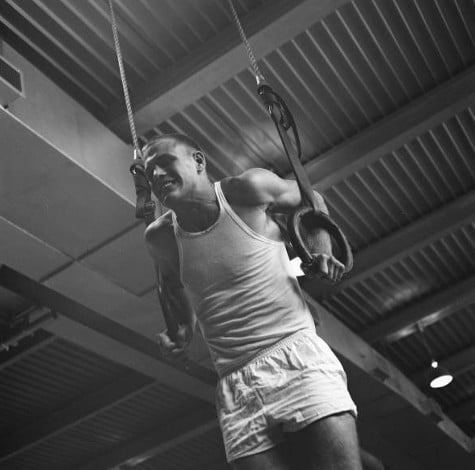
Editor’s Note: This is a guest series from Ryan Hurst.
Welcome to day three of our series on using gymnastic rings as part of your exercise routine. On Monday, we covered why to get into rings and offered tips on which rings to get and where to hang them; on Tuesday, we covered how to grip the rings. Today, we’ll get you started with a beginner’s routine that will have you building strength and confidence on the rings in no time. Plus we’ll address some common FAQs that tend to crop up when you’re first starting out.
Starting Rings Routine
It’s time to show you how to get started working out using gymnastic rings.
Warm-up and Cool-down
The video below shares a rings-specific warm-up and post-workout stretching routine:
The Fundamental Routine
In this workout routine, you’ll be practicing the fundamental movements that take advantage of the best qualities of the rings and get you on the road to increased upper body and core strength. The video below walks you through all the basic rings exercises.
- Top Position Hold – 3 sets of 5-10 seconds. A deceptively difficult position that is far from easy to perform, this exercise challenges the strength and stability of even the strongest people in their first time on the rings.
- Dips – 3 sets of 3-5 reps. This classic bodyweight exercise for the chest, shoulders, and arms is made harder by the instability of the rings.
- Reverse Row Sit Back – 3 sets of 3 reps. This move combines a row and chin-up, and teaches coordination and body control; it also strengthens all areas of the back.
- Tuck/L-Sit – 3 sets of 5-10 seconds. A first step into leverage holds; there are hardly any better exercises than this for your core.
- Chin-Up/Pull-Up – 3 sets of 1-3 reps. Just like dips, this is a standard bodyweight exercise for a reason. It’s the most efficient way to strengthen your entire upper body and core. Tighten your butt and legs as you do it, and it turns into a full body move.
Do this routine 3 times a week and you’ll be reaping the unique benefits of rings training within a few weeks. You can add it on to your current training if you like, but make sure you adjust your workouts as needed so you don’t overdo it.
FAQs and Troubleshooting
This is really hard. What if I can’t do a single rep on the first exercise?
This is hard. It really is. That’s what makes it so good for you! That being said, there’s always a way to scale back an exercise to make it doable for you.
Let’s take the Top Position Hold, for example. Use a sturdy box/stool/chair, and stand on it so that you can get into the top position while still on the box (lower the rings as needed or get a taller object to stand on). Hold there for time. As you get better, put more weight onto your arms and less on your feet.
The two primary issues in the beginning are using your full weight and the shakiness and instability you feel. You can improve those things by lessening the weight (either by adjusting the rings down or elevating your starting point, or both), and improving the stability (either by keeping your feet grounded or decreasing the length of the strapping). You can apply these principles to nearly every ring exercise, especially in the beginning with the basic exercises.
Do I need grips or chalk?
Grips? No. Chalk? That’s a good idea. Chalk helps provide some traction and decreases slipping from sweat or other moisture. A block of magnesium chalk is just a few bucks and will last you forever. Click here to see an article I wrote on grips and hand care for working with gymnastic rings.
Can I do “X” move without the basic progressions you mention? I really, really want to.
Well, go right ahead. I’m sure your health insurance company would love to foot your medical bills.
Seriously, just as in everything, patience and smart progression will win out in the end. Don’t be in such a hurry to get somewhere that you break down and never even get out the driveway.
How long will it take to get “X” move?
I’ll use my favorite answer for that one: “It depends.”
It depends on how strong you are in the first place, how flexible you need to be to make it happen, and how flexible you are right now, how much time you are willing to devote to it, how consistent you are in your training, how good you are at recovering from your training…and so on.
What if I fall on my head?
It’ll hurt. Hopefully, not too badly.
Basically, the only way you’ll fall on your head is if your grip slips, or if you let go. So number one, don’t let go of the rings, ever. Never. Only release the rings when you know and are comfortable with what you are going to land on. If you do feel your hands slipping, grip as hard as you can and get your feet under you quickly.
Are there leg exercises?
No, not really. There are ways you could use the rings like other suspension equipment (e.g. TRX) and do assisted squats and other such exercises. But really, that’s not the best use of the rings or the best way to work your legs. Go ahead and do squats and run hills after your rings sessions. Those are good for you.
Can I use TRX straps instead?
For most of the exercises we’ve shown here, yes. But as you get going on the rings and want to start with the combination moves, such as the muscle-up and tuck-to-tuck shoulder stand, the TRX isn’t going to cut it. The TRX was designed for certain purposes, as were the rings. You can do pretty much all the TRX exercises using the rings, but you can’t do all the rings exercises on the TRX.
Can I use rings every day?
It’s possible, but you’ll have to be very good at regulating your intensity and effort, and be aware of how your performance changes from day to day. Pick the good days where all cylinders are firing and work hard. Take note of the days when you are floundering, and just do the minimum.
Skill training every day is a fast way to improve, but don’t fall into the trap of going as hard as you can every time. Adolescents and teenagers may be able to do it without injuring themselves, but adults will have a much more difficult experience.
What’s Next?

After you’ve spent a couple months on the rings focusing on the fundamental movements as outlined above, you’ll have gained a good base of strength and have a better familiarity of the rings. At that point, you could continue on with the same exercises and work on increasing your sets and repetitions and holding times, or you could move on to the more complex skills that form the hallmark of rings training.
These combination movements take advantage of the characteristics of the rings that make them so different from free weights, machines, and even a fixed pull-up bar. Moving your body from below to above the rings and vice versa is a great demonstration of strength and body control.
The muscle-up (detailed illustration coming tomorrow) is one such move that’s been a sign of rings proficiency in recent years. It may be a simple move for gymnasts, but for non-gymnasts it’s a great skill to work toward, and it indicates a good level of strength, flexibility, and coordination.
The L-Sit-to-Handstand — and the easier version of the Tuck-to-Tuck Shoulder Stand — requires significant balance, body control, and more than a decent amount of strength.
These and other moves like them take you out of your normal gym and home exercises. They challenge not just your body, but also your mind, with the need for increased concentration and introspection to analyze your errors, and correct them for your next attempts.
Take your time and build your strength and stability in the rings with the fundamental exercises, but don’t be afraid to step out of those and try newer and more difficult skills.
What are you waiting for? Get going!
Don’t let the incredible and impossible feats of strength and skill of Olympic-level gymnasts deter you from working out on the rings. In this post I’ve taken you from scratch to performing good fundamental exercises, and within a few weeks of dedicated practice I bet you’ll experience increased strength in moves you wouldn’t have thought possible, along with a feeling of overall body connection and control.
Ring work is difficult — there’s no way around that. But the fact that you can progress to keep it challenging is why they are so useful for improving our strength and fitness.
The rings are a great tool for improving your strength, mobility, and coordination, and you don’t have to be a gymnast to enjoy these awesome benefits.
Read the Other Articles in the Series:
- Why to Use Rings, How to Buy Them, and Where to Hang Them
- How to Grip the Rings
- A Beginner’s Routine and FAQs
- How to Perform a Muscle-Up
_________________________
Ryan Hurst is a former junior national level gymnast and holds several black belts in Japanese martial arts, along with many years of experience teaching strength and skills work that combine all the aspects of his diverse knowledge base. He is a co-founder of GMB Fitness (http://gmb.io), which specializes in teaching body skill development to people of all athletic levels.
He also provides a free Ultimate Guide to Rings Training for beginners that takes you step-by-step into all the benefits of rings training.
Tags: Exercises

